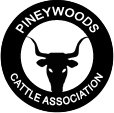Conservation breeding is somewhat different than production breeding, but is essential if the various strains of the Pineywoods cattle are to see the next few decades.
Conservation programs are tailored to maximize the genetic survival of a strain by minimizing overall inbreeding. While many of the Pineywoods strains have been very resistant to any ill effects of inbreeding, it is still best to manage populations with an eye towards minimizing inbreeding. By that strategy it is possible to avoid problems should they begin to arise. By ignoring inbreeding it becomes impossible to avoid its ill effect should they ever occur.
The basic conservation breeding program has three bull lines go through a single herd, at annual intervals. The details are in the “Conservation Breeding Handbook” available from the American Livestock Breeds Conservancy. This is a summary of that work.
Year one, an “A” bull is used over all the cows.
Year two, A line calves are born, a B line bull is used.
Year three, B line calves are born, a C line bull is used.
year four, C line calves are born, an A line bull is used.
and so on.
This system works well, but only if breeders can see the wisdom of using a bull for only one year. That can be tough, because the bulls are turned over just as they begin to show their full potential. Deciding to not use bulls at this stage can be very difficult. In a conservation sense, though, it is valuable to consider what happens if a single bull is used for several years. In the first year, his daughters and sons are born. In subsequent years, he is likely to be mated to his daughters as well as to the original cows. The result of this is that if the bull is used for much over one year, his genetic influence swamps the entire herd. In order to balance his contributions with those of the cows, it is necessary to limit the use of any one bull. Otherwise his influence is too great in the herd and the entire herd is too closely related to a single bull. For the long term, it is much better to have the herd balanced between three lines that are rotated in their use in the herd.
In a conservation program for a single strains, all three lines (A, B, C) are from the same strain (Conway or Hickman, for example). This allows for slightly different types, colors, or families of the strain to all persist into the future.
Some conservation programs will be more targeted to trying to salvage more than one rare strain. For example, Hickmand and Ladnier cattle are similar in type and in origin, but if all the Ladnier cattle are used in a Hickman program, then they will eventually not have any genetic impact as the Ladnier influence is replaced by Hickman genetics generation by generation. What makes more sense is to designate Ladnier as one of the lines (A, for example) and then Hickman as B and C. In this way it is possible to save a predominantly Ladnier bull every third year, and that assures the production of high percentage Ladnier cattle in the herd.
A similar program can be tailored for three rare lines, such as Palmer, Agricola, and Barnes. As the generations proceed, eventually all cattle will be some mixture of these three lines. However, by selecting replacement bulls that are linebred to each of these lines (select replacements from high percentage cows) the resulting calf crop is brought more in that direction than in a general mix. The selection of linebred bulls tugs the population back in the direction of the founding lines at each step.
If conservation is successful and numbers of the various strains stabilize, then it is possible and also wise to use cattle in breeding herds that are tailored as much for production as for conservation. If conservation fails, though, then the components that will be necessary for production will also have not been saved. Conservation really needs to come first, and by doing a good job on conservation most breeders will also discover that they have taken care of production at the same time. If production is put first, and conservation considerations are not taken in to account, then it frequently happens that both production and conservation fail. The Pineywoods cattle breed deserves much better than that!
Composite herds
While strain rescue and conservation are important to the Pineywoods cattle breed, they are by no means the whole story. Successful and important programs will also be built on composites of the different strains. The reason for keeping strains intact is to keep the pieces of the breed intact. Those pieces can then be put together by breeders to see what works for different goals and situations.
Composites can work for a variety of good purposes. One is to mix up the genetics of the various strains to see which combinations are most productive. One of the advantages of strain crosses is the hybrid vigor that is obtained – the resulting cattle are likely to be robust and productive. Such cattle are a delight to own and use. These cattle are important to the breed, because they show what the breed is capable of producing. It is important to remember, though, that unless the component strains are also saved, then the cross producing these wonderful cattle cannot be repeated because the pieces that went into it are now missing!
Composites should be developed and their production characterized. This is important for the entire breed, because the breed has a secure future to the extent that production-minded breeders take it seriously and use it for its many strengths.
